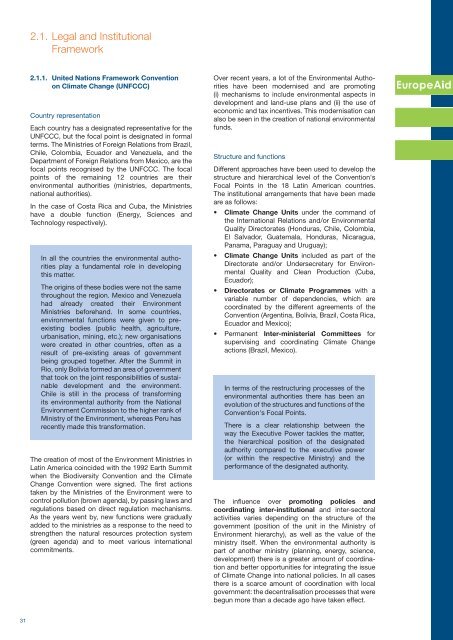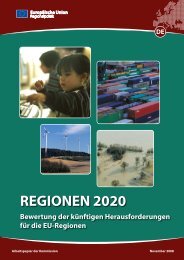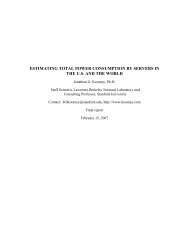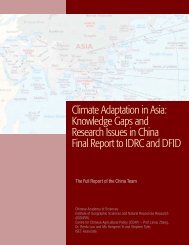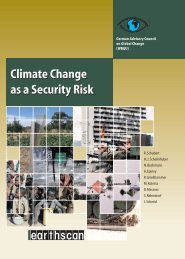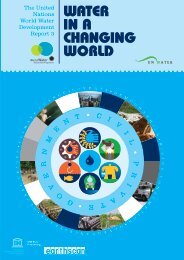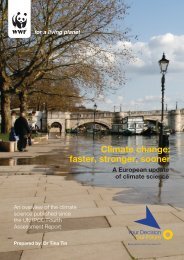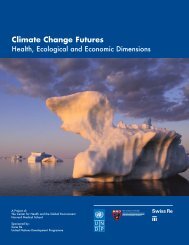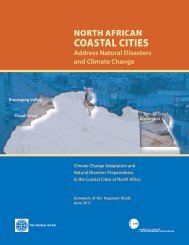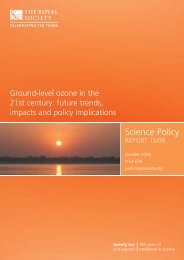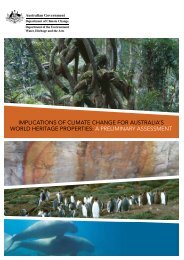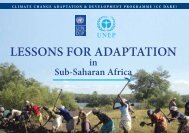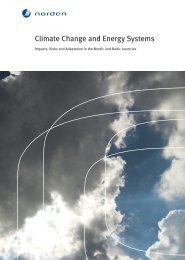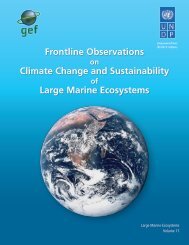Climate Change in Latin America - European Commission
Climate Change in Latin America - European Commission
Climate Change in Latin America - European Commission
Create successful ePaper yourself
Turn your PDF publications into a flip-book with our unique Google optimized e-Paper software.
2.1. Legal and Institutional<br />
Framework<br />
2.1.1. United Nations Framework Convention<br />
on <strong>Climate</strong> <strong>Change</strong> (UNFCCC)<br />
Country representation<br />
Each country has a designated representative for the<br />
UNFCCC, but the focal po<strong>in</strong>t is designated <strong>in</strong> formal<br />
terms. The M<strong>in</strong>istries of Foreign Relations from Brazil,<br />
Chile, Colombia, Ecuador and Venezuela, and the<br />
Department of Foreign Relations from Mexico, are the<br />
focal po<strong>in</strong>ts recognised by the UNFCCC. The focal<br />
po<strong>in</strong>ts of the rema<strong>in</strong><strong>in</strong>g 12 countries are their<br />
environmental authorities (m<strong>in</strong>istries, departments,<br />
national authorities).<br />
In the case of Costa Rica and Cuba, the M<strong>in</strong>istries<br />
have a double function (Energy, Sciences and<br />
Technology respectively).<br />
In all the countries the environmental authorities<br />
play a fundamental role <strong>in</strong> develop<strong>in</strong>g<br />
this matter.<br />
The orig<strong>in</strong>s of these bodies were not the same<br />
throughout the region. Mexico and Venezuela<br />
had already created their Environment<br />
M<strong>in</strong>is tries beforehand. In some countries,<br />
environmental functions were given to preexist<strong>in</strong>g<br />
bodies (public health, agriculture,<br />
urbanisation, m<strong>in</strong><strong>in</strong>g, etc.); new organisations<br />
were created <strong>in</strong> other countries, often as a<br />
result of pre-exist<strong>in</strong>g areas of government<br />
be<strong>in</strong>g grouped together. After the Summit <strong>in</strong><br />
Rio, only Bolivia formed an area of government<br />
that took on the jo<strong>in</strong>t responsibilities of susta<strong>in</strong>able<br />
development and the environment.<br />
Chile is still <strong>in</strong> the process of transform<strong>in</strong>g<br />
its environmental authority from the National<br />
Environment <strong>Commission</strong> to the higher rank of<br />
M<strong>in</strong>istry of the Environment, whereas Peru has<br />
recently made this transformation.<br />
The creation of most of the Environment M<strong>in</strong>istries <strong>in</strong><br />
Lat<strong>in</strong> <strong>America</strong> co<strong>in</strong>cided with the 1992 Earth Summit<br />
when the Biodiversity Convention and the <strong>Climate</strong><br />
<strong>Change</strong> Convention were signed. The first actions<br />
taken by the M<strong>in</strong>istries of the Environment were to<br />
control pollution (brown agenda), by pass<strong>in</strong>g laws and<br />
regulations based on direct regulation mechanisms.<br />
As the years went by, new functions were gradually<br />
added to the m<strong>in</strong>istries as a response to the need to<br />
strengthen the natural resources protection system<br />
(green agenda) and to meet various <strong>in</strong>ternational<br />
commitments.<br />
Over recent years, a lot of the Environmental Authorities<br />
have been modernised and are promot<strong>in</strong>g<br />
(i) mechanisms to <strong>in</strong>clude environmental aspects <strong>in</strong><br />
development and land-use plans and (ii) the use of<br />
economic and tax <strong>in</strong>centives. This modernisation can<br />
also be seen <strong>in</strong> the creation of national environmental<br />
funds.<br />
Structure and functions<br />
Different approaches have been used to develop the<br />
structure and hierarchical level of the Convention's<br />
Focal Po<strong>in</strong>ts <strong>in</strong> the 18 Lat<strong>in</strong> <strong>America</strong>n countries.<br />
The <strong>in</strong>stitutional arrangements that have been made<br />
are as follows:<br />
• <strong>Climate</strong> <strong>Change</strong> Units under the command of<br />
the International Relations and/or Environmental<br />
Quality Directorates (Honduras, Chile, Colombia,<br />
El Salvador, Guatemala, Honduras, Nicaragua,<br />
Panama, Paraguay and Uruguay);<br />
• <strong>Climate</strong> <strong>Change</strong> Units <strong>in</strong>cluded as part of the<br />
Directorate and/or Undersecretary for Environmental<br />
Quality and Clean Production (Cuba,<br />
Ecuador);<br />
• Directorates or <strong>Climate</strong> Programmes with a<br />
variable number of dependencies, which are<br />
coord<strong>in</strong>ated by the different agreements of the<br />
Convention (Argent<strong>in</strong>a, Bolivia, Brazil, Costa Rica,<br />
Ecuador and Mexico);<br />
• Permanent Inter-m<strong>in</strong>isterial Committees for<br />
supervis<strong>in</strong>g and coord<strong>in</strong>at<strong>in</strong>g <strong>Climate</strong> <strong>Change</strong><br />
actions (Brazil, Mexico).<br />
In terms of the restructur<strong>in</strong>g processes of the<br />
environmental authorities there has been an<br />
evolution of the structures and functions of the<br />
Convention's Focal Po<strong>in</strong>ts.<br />
There is a clear relationship between the<br />
way the Executive Power tackles the matter,<br />
the hierarchical position of the designated<br />
authority compared to the executive power<br />
(or with<strong>in</strong> the respective M<strong>in</strong>istry) and the<br />
performance of the designated authority.<br />
The <strong>in</strong>fluence over promot<strong>in</strong>g policies and<br />
coord<strong>in</strong>at<strong>in</strong>g <strong>in</strong>ter-<strong>in</strong>stitutional and <strong>in</strong>ter-sectoral<br />
activities varies depend<strong>in</strong>g on the structure of the<br />
government (position of the unit <strong>in</strong> the M<strong>in</strong>istry of<br />
Environment hierarchy), as well as the value of the<br />
m<strong>in</strong>istry itself. When the environmental authority is<br />
part of another m<strong>in</strong>istry (plann<strong>in</strong>g, energy, science,<br />
development) there is a greater amount of coord<strong>in</strong>ation<br />
and better oppor tunities for <strong>in</strong>tegrat<strong>in</strong>g the issue<br />
of <strong>Climate</strong> <strong>Change</strong> <strong>in</strong>to national policies. In all cases<br />
there is a scarce amount of coord<strong>in</strong>ation with local<br />
government: the decentralisation processes that were<br />
begun more than a decade ago have taken effect.<br />
31


